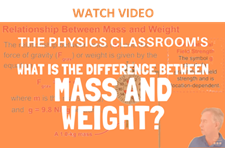What Type Of Forces Causes Changes In Motion?
Types of Forces
A force is a push or pull acting upon an object as a event of its interaction with another object. At that place are a variety of types of forces. Previously in this lesson, a variety of force types were placed into two broad category headings on the footing of whether the force resulted from the contact or non-contact of the ii interacting objects. An applied force is a force that is applied to an object past a person or another object. If a person is pushing a desk across the room, then in that location is an applied force acting upon the object. The applied force is the force exerted on the desk by the person. The force of gravity is the force with which the world, moon, or other massively large object attracts another object towards itself. Past definition, this is the weight of the object. All objects upon world experience a force of gravity that is directed "downward" towards the center of the earth. The force of gravity on earth is always equal to the weight of the object as found by the equation: and m = mass (in kg) (Circumspection: exercise not confuse weight with mass.) Return to Pinnacle The normal force is the back up force exerted upon an object that is in contact with another stable object. For example, if a book is resting upon a surface, so the surface is exerting an up force upon the volume in order to support the weight of the book. On occasions, a normal force is exerted horizontally between two objects that are in contact with each other. For instance, if a person leans against a wall, the wall pushes horizontally on the person. The friction forcefulness is the force exerted past a surface as an object moves beyond information technology or makes an attempt to motion across it. At that place are at least two types of friction forcefulness - sliding and static friction. Though it is not always the case, the friction force often opposes the motion of an object. For example, if a book slides beyond the surface of a desk-bound, and then the desk exerts a friction force in the opposite direction of its motion. Friction results from the two surfaces being pressed together closely, causing intermolecular attractive forces between molecules of different surfaces. As such, friction depends upon the nature of the two surfaces and upon the degree to which they are pressed together. The maximum amount of friction strength that a surface can exert upon an object can be calculated using the formula below: Ffrict = µ • Fnorm The friction force is discussed in more detail subsequently this page. The air resistance is a special type of frictional force that acts upon objects every bit they travel through the air. The force of air resistance is often observed to oppose the motion of an object. This force volition frequently be neglected due to its negligible magnitude (and due to the fact that information technology is mathematically difficult to predict its value). It is most noticeable for objects that travel at high speeds (e.g., a skydiver or a downhill skier) or for objects with large surface areas. Air resistance will be discussed in more detail in Lesson 3. The tension forcefulness is the force that is transmitted through a string, rope, cable or wire when it is pulled tight by forces interim from opposite ends. The tension strength is directed forth the length of the wire and pulls equally on the objects on the opposite ends of the wire. The jump forcefulness is the force exerted by a compressed or stretched bound upon any object that is attached to it. An object that compresses or stretches a spring is always acted upon past a force that restores the object to its residual or equilibrium position. For nearly springs (specifically, for those that are said to obey "Hooke's Law"), the magnitude of the force is directly proportional to the amount of stretch or compression of the spring. On the other hand, the weight of an object (measured in Newton) will vary according to where in the universe the object is. Weight depends upon which planet is exerting the force and the altitude the object is from the planet. Weight, beingness equivalent to the force of gravity, is dependent upon the value of one thousand - the gravitational field strength. On world's surface grand is 9.eight N/kg (often approximated as 10 N/kg). On the moon's surface, g is 1.7 Northward/kg. Become to another planet, and there volition be another g value. Furthermore, the g value is inversely proportional to the distance from the center of the planet. So if we were to measure g at a distance of 400 km higher up the world'due south surface, and then we would find the chiliad value to be less than 9.8 N/kg. (The nature of the strength of gravity will be discussed in more detail in a subsequently unit of The Physics Classroom.) Ever be cautious of the stardom between mass and weight. Information technology is the source of much confusion for many students of physics.
 These types of individual forces will now exist discussed in more detail. To read about each force listed above, proceed scrolling through this page. Or to read about an private force, click on its name from the list below.
These types of individual forces will now exist discussed in more detail. To read about each force listed above, proceed scrolling through this page. Or to read about an private force, click on its name from the list below.
Confusion of Mass and Weight
 A few further comments should be added about the single force that is a source of much confusion to many students of physics - the strength of gravity. As mentioned above, the force of gravity acting upon an object is sometimes referred to as the weight of the object. Many students of physics confuse weight with mass. The mass of an object refers to the amount of affair that is independent by the object; the weight of an object is the force of gravity acting upon that object. Mass is related to how much stuff is there and weight is related to the pull of the World (or any other planet) upon that stuff. The mass of an object (measured in kg) will be the same no affair where in the universe that object is located. Mass is never altered by location, the pull of gravity, speed or fifty-fifty the existence of other forces. For instance, a two-kg object will have a mass of 2 kg whether it is located on Globe, the moon, or Jupiter; its mass will be two kg whether information technology is moving or not (at least for purposes of our written report); and its mass volition be 2 kg whether it is existence pushed upon or not.
A few further comments should be added about the single force that is a source of much confusion to many students of physics - the strength of gravity. As mentioned above, the force of gravity acting upon an object is sometimes referred to as the weight of the object. Many students of physics confuse weight with mass. The mass of an object refers to the amount of affair that is independent by the object; the weight of an object is the force of gravity acting upon that object. Mass is related to how much stuff is there and weight is related to the pull of the World (or any other planet) upon that stuff. The mass of an object (measured in kg) will be the same no affair where in the universe that object is located. Mass is never altered by location, the pull of gravity, speed or fifty-fifty the existence of other forces. For instance, a two-kg object will have a mass of 2 kg whether it is located on Globe, the moon, or Jupiter; its mass will be two kg whether information technology is moving or not (at least for purposes of our written report); and its mass volition be 2 kg whether it is existence pushed upon or not. Flickr Physics Photo
Investigate!
Fifty-fifty on the surface of the Earth, there are local variations in the value of g that have very small furnishings upon an object's weight. These variations are due to latitude, altitude and the local geological structure of the region. Use the Gravitational Fields widget beneath to investigate how location affects the value of chiliad.
Sliding versus Static Friction
 As mentioned in a higher place, the friction force is the forcefulness exerted by a surface every bit an object moves beyond information technology or makes an effort to move across it. For the purpose of our report of physics at The Physics Classroom, there are ii types of friction forcefulness - static friction and sliding friction. Sliding friction results when an object slides beyond a surface. As an example, consider pushing a box beyond a floor. The flooring surface offers resistance to the movement of the box. We often say that the floor exerts a friction force upon the box. This is an instance of a sliding friction force since it results from the sliding movement of the box. If a car slams on its brakes and skids to a finish (without antilock brakes), at that place is a sliding friction force exerted upon the motorcar tires past the roadway surface. This friction strength is likewise a sliding friction force because the car is sliding across the road surface. Sliding friction forces can be calculated from knowledge of the coefficient of friction and the normal strength exerted upon the object by the surface it is sliding across. The formula is:
As mentioned in a higher place, the friction force is the forcefulness exerted by a surface every bit an object moves beyond information technology or makes an effort to move across it. For the purpose of our report of physics at The Physics Classroom, there are ii types of friction forcefulness - static friction and sliding friction. Sliding friction results when an object slides beyond a surface. As an example, consider pushing a box beyond a floor. The flooring surface offers resistance to the movement of the box. We often say that the floor exerts a friction force upon the box. This is an instance of a sliding friction force since it results from the sliding movement of the box. If a car slams on its brakes and skids to a finish (without antilock brakes), at that place is a sliding friction force exerted upon the motorcar tires past the roadway surface. This friction strength is likewise a sliding friction force because the car is sliding across the road surface. Sliding friction forces can be calculated from knowledge of the coefficient of friction and the normal strength exerted upon the object by the surface it is sliding across. The formula is:
The symbolμfrict-sliding represents the coefficient of sliding friction between the 2 surfaces. The coefficient value is dependent primarily upon the nature of the surfaces that are in contact with each other. For well-nigh surface combinations, the friction coefficients evidence little dependence upon other variables such as area of contact, temperature, etc. Values ofμsliding have been experimentally determined for a diversity of surface combinations and are oft tabulated in technical manuals and handbooks. The values of μ provide a measure of the relative corporeality of adhesion or attraction of the ii surfaces for each other. The more that surface molecules tend to adhere to each other, the greater the coefficient values and the greater the friction force.
Friction forces can as well exist when the two surfaces are non sliding beyond each other. Such friction forces are referred to as static friction. Static friction results when the surfaces of 2 objects are at rest relative to i another and a force exists on i of the objects to set up information technology into motion relative to the other object. Suppose y'all were to push button with five-Newton of force on a big box to movement it across the floor. The box might remain in place. A static friction force exists between the surfaces of the flooring and the box to prevent the box from beingness gear up into motion. The static friction forcefulness balances the force that you exert on the box such that the stationary box remains at rest. When exerting five Newton of applied force on the box, the static friction force has a magnitude of 5 Newton. Suppose that y'all were to push with 25 Newton of force on the large box and the box were to still remain in place. Static friction now has a magnitude of 25 Newton. Then suppose that y'all were to increase the strength to 26 Newton and the box finally budged from its resting position and was set into motility beyond the floor. The box-floor surfaces were able to provide upwards to 25 Newton of static friction force to match your practical force. Yet the two surfaces were not able to provide 26 Newton of static friction strength. The amount of static friction resulting from the adhesion of any two surfaces has an upper limit. In this instance, the static friction force spans the range from 0 Newton (if there is no force upon the box) to 25 Newton (if you push on the box with 25 Newton of forcefulness). This relationship is often expressed as follows:
The symbol μfrict-static represents the coefficient of static friction between the 2 surfaces. Like the coefficient of sliding friction, this coefficient is dependent upon the types of surfaces that are attempting to move beyond each other. In full general, values of static friction coefficients are greater than the values of sliding friction coefficients for the same two surfaces. Thus, it typically takes more than force to budge an object into move than it does to maintain the motion in one case information technology has been started.
The meaning of each of these forces listed in the table above will accept to exist thoroughly understood to be successful during this unit. Ultimately, you must exist able to read a exact description of a physical situation and know enough about these forces to recognize their presence (or absence) and to construct a complimentary-body diagram that illustrates their relative magnitude and direction.
Nosotros Would Similar to Suggest ...
 Sometimes it isn't enough to only read about it. You have to interact with it! And that'due south exactly what you do when you employ i of The Physics Classroom's Interactives. We would like to suggest that you combine the reading of this page with the utilize of our Gratuitous-Body Diagram Interactive. Y'all can find it in the Physics Interactives section of our website. The Free-Torso Diagram Interactive allows a learner to practice identifying the forces that human action upon an object and to limited such an understanding by the structure of a free-body diagram.
Sometimes it isn't enough to only read about it. You have to interact with it! And that'due south exactly what you do when you employ i of The Physics Classroom's Interactives. We would like to suggest that you combine the reading of this page with the utilize of our Gratuitous-Body Diagram Interactive. Y'all can find it in the Physics Interactives section of our website. The Free-Torso Diagram Interactive allows a learner to practice identifying the forces that human action upon an object and to limited such an understanding by the structure of a free-body diagram.
Bank check Your Understanding
1. Complete the following table showing the relationship between mass and weight.
| | | |
| | | |
| | | |
| | | |
| | | |
2. Unlike masses are hung on a spring scale calibrated in Newtons.
- The force exerted by gravity on 1 kg = 9.8 Due north.
- The forcefulness exerted by gravity on 5 kg = ______ N.
- The force exerted by gravity on _______ kg = 98 Northward.
- The force exerted by gravity on lxx kg = ________ Due north.
three. When a person diets, is their goal to lose mass or to lose weight? Explain.
Source: https://www.physicsclassroom.com/class/newtlaws/Lesson-2/Types-of-Forces
Posted by: namcoursocied1958.blogspot.com


0 Response to "What Type Of Forces Causes Changes In Motion?"
Post a Comment